A trip to the capital of China, Beijing, requires more than just prior reservations; the glimpse into its rich history, coupled with its local charm, makes it appear to be an overwhelming part of planning. This 3-day itinerary is tailored to enable compelling city exploration whilst ensuring a taste of classical and modern landmarks and scrumptious food. You will relish Beijing’s vibrant urban setting for three consecutive days while enjoying the charm of the historic hutongs, the marvels of the Great Wall, and the stunning Forbidden City. If you are a traveler, a history buff, or a foodie, the perfect guide will help you plan your trip to Beijing seamlessly. With each moment spent in this famous city, take some time and readily enjoy the enchantment it offers!
How to Plan Your 3-Day Beijing Itinerary?
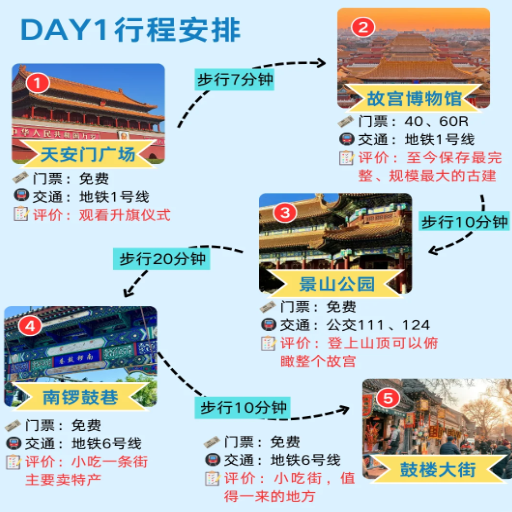
How to Plan Your 3-Day Beijing Itinerary
Planning your three-day trip to Beijing requires a good mix of sightseeing, rest, and cultural activities. Make sure to capture the top priority attractions like the Forbidden City, The Great Wall, and the Temple of Heaven. Each one is unique and needs enough time to appreciate its beauty fully. Allocate your schedule to reduce attraction travel time – focus on the central sites on day one, venture out to the Great Wall on day two, and end with a blend of historic hutongs and modern neighborhoods on day three, including tasting the local dishes and being spontaneous when looking for diamonds in the rough. Thoughtful planning can help you make the most of your time while overlooking anything important in Beijing.
What to Expect on Your First Day in Beijing?
With all the beautiful sights to view on your first day in Beijing, it will feel fulfilling and exciting. To kick things off, start your journey at Tiananmen, where you can appreciate the center of Beijing and its overall beauty. After that, I recommend you venture to the Forbidden City, a beautiful and massive palace complex of imperial architecture representing rich history over the centuries.
Tips for Your First Day:
- Timing: To reduce waiting-based setbacks, I suggest you arrive early, especially during the heavy-loaded seasons.
- Travel: If you need to travel in Beijing, the subway is a good option (Line 1 stops at either Tiananmen East or Tiananmen West).
- Entry Requirements: If you plan to see the Forbidden City, purchasing tickets to enter in advance is usually preferred, as same-day tickets are uncommon.
- Clothing: You will likely walk a lot, so it is advised to wear comfortable walking shoes. Depending on the season, you may also want to dress in layers since you might spend a few hours outdoors.
- Photography: Most outdoor areas do allow photography, but there may be some outdoor zones for which you will need to look at signage to see if they are restricted.
As the day wraps up, visit Wangfujing Street, famous for its shopping and dining, for dinner or a stroll. Remember to allocate some time to deal with jet lag so that you can take in the lively energy of Beijing.
How to Make the Most of Your 3 Days in Beijing?
Based on what I have experienced, to enjoy the 3 days in Beijing truly, one has to plan and, most importantly, know how to prioritize the city’s cultures, history, and modern life. On your first day, start early and try to make it to the Forbidden City and Tiananmen Square, as both these landmarks are a must and will take a few hours each. Afterward, you should go to Jingshan Park to glimpse the ancient city’s panoramic view. Wangfujing Street is a place that offers traditional snacks and makes a great spot to end your day.
On Day 2, you should visit the Great Wall of China. Its ministry alone is spectacular. However, I recommend the Mutianyu section, which is less frequent but still has a breathtaking and restored path. Make sure you have comfortable shoes and some water handy, but this leg of the journey will require at least half a day. You can return to the city in the evening and visit the Temple of Heaven there.
Day 3 can be utilized by spending time at the Summer Palace. The location itself is breathtaking, enabling boat rides and other leisure activities. Don’t forget your camera for this location. Before you end your trip, visiting Beijing’s Hutongs is also a must, these narrow alodways showcase the traditional lifestyle within the city.
Essential Tips to Optimize Your Trip:
- Travel Time: For someone looking to visit the Great Wall, be sure to arrive early around; it generally opens between 7-8 AM,
- Transport: For shorter distances, combine taxi services with the highly efficient and cost-effective Beijing Subway.
- Tickets: To save time, purchase attraction tickets for The Forbidden City and other landmarks in advance to skip the lines.
With the right blend of local culture and landmark visits, your three days in Beijing will be unforgettable.
Essential Tips for Your Beijing Travel
- Currency and Payment Methods: The Chinese Yuan (CNY) is the local currency. Payments for taxis and meals at most local restaurants can be settled through mobile payments like WeChat Pay and Alipay. However, a Chinese bank account is usually a prerequisite. Always have some cash on hand in case mobile payment fails. Money can be exchanged at banks or authorized exchange counters at a lesser fee.
- Weather Considerations: Beijing has extremely variable seasonal differences. Summer (July-August) can be hot and sticky, ranging from 25 to 35 degrees Celsius or 77-95 degrees Fahrenheit. Winter (December-February) can be brutal due to the low temperatures of -7 degrees Celsius or 19 degrees Fahrenheit. Autumn (September-November) is fantastic, with towering temperatures averaging 10 to 20 degrees Celsius, or 50-68 degrees Fahrenheit. Check the forecast before your trip and pack according to the weather.
- Electricity and Adapters: China’s voltage standard is 220V with a 50Hz frequency. Type A, C, and I plugs are used as the primary receptacles, and the policy states that adapters with universal receptacles would benefit devices with differing plug styles.
- Internet and Apps: Public Wi-Fi is available in many locations, but a local number is usually mandated. A VPN is a must for anyone wishing to circumvent China’s internet restrictions. Accessing Instagram or WhatsApp and any apps based outside of China is necessary. For those planning to travel, reputable VPNs such as ExpressVPN and NordVPN should be set up before arriving.
- Cultural Etiquette: Follow customs such as public orderliness and avoid loud conversations. When visiting temples, dress modestly and avoid finger gestures to statues.
By following these tips and preparing adequately, you can enjoy your visit to Beijing to the fullest!
What to Do on Day 1 of Your Beijing Tour?
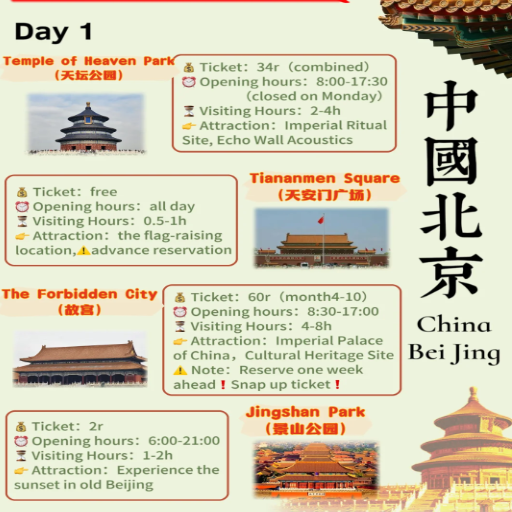
What to Do on Day 1 of Your Beijing Tour
Start your day at Tiananmen Square, a historic site. Then, go to the nearby Forbidden City, which used to be an imperial palace for many centuries. Make sure to investigate its complex halls and yards. After that, eat at a traditional Chinese eatery and try Peking duck or dumplings. Spend your Jingshan Park while enjoying breathtaking views of the entire city of Beijing. Conclude your day by walking to Wangfujing Street to learn about Chinese culture.
Exploring the Historic Forbidden City
The stunning Forbidden City exemplifies Ancient Chinese architecture and history at the heart of Beijing. Following are simple answers to common questions regarding this magnificent landmark of the world:
- What is the size of the Forbidden City?
The Forbidden City is about 720,000 square meters or 180 acres. It consists of about 980 structures and more than 8700 rooms, making it one of the largest palace complexes in the world.
- When was it constructed?
The construction of the Forbidden City commenced in 1406 and was finished in 1420 during the reign of the Yongle Emperor of the Ming dynasty. The entire process took approximately 14 years.
- What architectural style does it represent?
What stands out is the traditional Chinese palatial architecture, which includes the hallmark wooden buildings, detailed carvings, and a courtyard with structures on each side. Its distinctive feature of red-colored walls coupled with golden roofs marks supremacy and virtue.
- What materials were used in construction?
The primary materials include timber(used for building the columns and beams), white marble(for platforms and railings), and glazed tiles (used for roofing). These materials not only give Possess a pleasing aesthetic but also durability.
- Are there viewing regulations for tourists?
According to the visitor’s guide, tourists must go through the Meridian Gate and the central halls in a specific order. However, taking photos in some places may not be allowed. Tickets need to be purchased beforehand on the online platform. As a rule, the complex restricts the number of visitors to 80,000 per day to avoid crowds.
Every time you visit the Forbidden City, you get a glimpse into the sophistication of Chinese imperial history. The importance of these refinements gives enormous detail about its design and culture.
Visiting Tiananmen Square: A Must-See Landmark
At 109 acres wide, Tiananmen Square is amongst the most populous squares around the globe and is geographically positioned in the downtown area of Beijing. The square is a vital point of China’s historical, cultural, and political backgrounds. It was built in 1651 and expanded later. It has been the center for hoisting several patriotic events that unify China in the modern era.
Noteworthy spots within Tiananmen Square include the Great Hall of the People, the Mausoleum of Mao Zedong, the Monument to the People’s Heroes, and the Tiananmen Tower. On the eastern side lies the National Museum of China, which has collections of thousands of modern and ancient relics. It is also known as the most prominent place in China where the military honor guard conducts the daily flag-rising and setting ceremonies.
Details for Visitors:
- Opening Hours: Visitors from outside typically tend to be present inside the square throughout the day; however, other linked tourists might have opening hours. It’s worth noting that there are set times for changing the garrison of guards.
- Ticket Information: There are no boundaries for getting into the square. Some landmarks around it, such as the Mausoleum of Mao Zedong, require ID registration before you go in.
- Crowd Control: The area is well guarded and meets all international standards, but there may be times when they have many people during their national holidays.
- Transport: You can reach Tiananmen Square using the Beijing Subway Lines 1 and 2, which stop at the convenient stations of Tiananmen East and Tiananmen West.
- Best Visiting Times: Early mornings and evenings are the best times to visit the square, as there are fewer people, which is optimal for capturing photographs.
To enjoy your visit, take time to fully absorb the area’s remarkable history, cultural significance, and many landmarks in the vast region.
Uncovering the Secrets of Jingshan Park
Nestled north of the Forbidden City, Jingshan Park depicts one of the most recognizable scenes in the historic heart of Beijing. The park has an elaborate ridge that branches out like the arms of a giant, which is a unique feature of this area. Observing how this old royal park so elegantly merges nature with age-old history was excellent. The King’s Central Park of Beijing marks the pride of China’s ancient engineering achievements. It is an ‘artificial’ hill raised during the soil excavation in the Ming dynasty’s moat around the Forbidden City. Placed at the peak is the Shen Wanchun Pavilion, with breathtaking views over Beijing fully open from her balcony, where she watches the ancient city with the Forbidden City skirts southward and the Drum and Bell Towers to the northern side, all collages of scenic sights at one glance.
Guests and tourists can also learn tai chi and enjoy on-site Chinese opera spectacles held every early morning. To aid the tourist, the park operates throughout the week and generally from six hours till sunset, with nominal charges of around two to ten yuan according to the particular season because of the cap on the number of tourists. This park testifies to Beijing’s majesty and ancient imperialism but also represents peace amid the busy cosmopolitan city.
How to Spend Day 2 at the Great Wall of China?
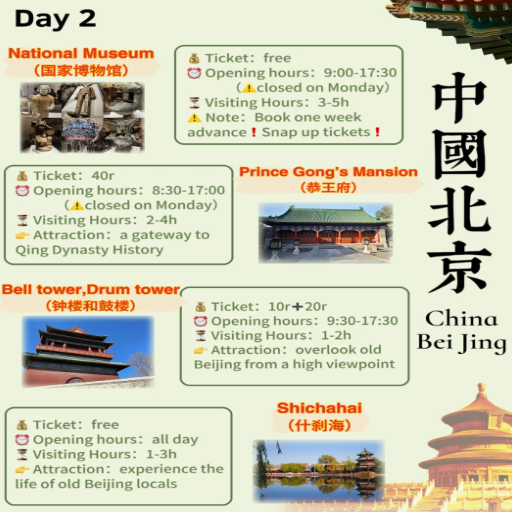
How to Spend Day 2 at the Great Wall of China
To enjoy your second day at The Great Wall of China, consider spending it at a less frequented section like the Mutianyu or Jinshanling. Not only do these locations have stunning views, but they also have well-maintained watchtowers, and you can enjoy the architectural mastery of the Wall itself. Get up early to beat the crowds and make the most of the cool morning weather, and don’t forget to pack water, small snacks, sunscreen, and comfortable walking shoes, as the trek can be steep and tiring. For a more enjoyable experience, you could take the cable car to the top and either toboggan down at Mutianyu or hike along quieter sections that offer great views.
Choosing the Best Section of the Great Wall to Visit
Every part of The Great Wall has unique characteristics and attractions that appeal to varying tastes and experiences. Here’s a summary to help you navigate the best sections considering your interests and requirements:
- Mutianyu
- Best for: Families, first-time visitors, scenic views
- Key Features: Well-maintained, cable car access, tobogganing available
- Difficulty Level: Moderate (steep areas but manageable)
- Badaling
- Best for: History enthusiasts, convenience, group tours
- Key Features: Busy preserved section with lots of visitor facilities
- Difficulty Level: Easy to Moderate (suitable for all ages)
- Jiankou
- Best for: Adventurers, photographers, off-the-beaten-path exploration
- Key Features: Untamed with steep mountain scenery, and part of rugged mountains with lots of steep and rough paths
- Difficulty Level: Challenging (experienced hikers recommended)
- Jinshanling
- Best for: Extended hikes, serene landscapes, fewer crowds
- Key Features: Mix of restored and original sections, excellent for photography
- Difficulty Level: Moderate to Difficult (long stretches of hiking)
- Huanghuacheng
- Best for: Nature lovers, unique water-side views
- Key Features: Partially submerged sections, tranquil surroundings
- Difficulty Level: Moderate
Consider your options alongside your physical capability and time constraints to find the exact section that caters to you!
What to Know About the Mutianyu Great Wall
The Mutianyu section is the best-preserved and among the most visited parts of the Great Wall. It is significant historically, has great picturesque views, and is accessible. Constructed first during the Northern Qi Dynasty (550-577) and later restructured in the Ming Dynasty (1368-1644), this stretch sports beautiful watchtowers and crenellations indicative of ancient military engineering marvels.
Best for: Families, casual hikers, and history enthusiasts
Key Features: A dense forest surrounding restored infrastructure, cable cars, and famous watchtowers. There is a toboggan slide that makes it more enjoyable for younger kids, making it suitable for all ages and fitness levels.
Difficulty Level: Easy to moderate, depending on the route taken
- Distance from Beijing: ~70 km
- Accessibility: Well-connected by car (1-1.5 hours) or shuttle bus services from the city.
- Facilities: Visitor center, restaurants, and toilets available.
Whether it’s about spending time with your family or trading rest for a gripping adventure, Mutianyu’s variety of facilities and rich history is the go-to place.
Taking a Day Trip to the Great Wall: Essential Tips
Organizing your day at the Great Wall requires a bit of foresight for things to go as planned. Preparations begin the night before. Set your alarm for an early start during the mornings to save time in the long run. When the time comes, ensure your footwear is comfortable, as the path can be steep and uneven. It may also be wise to consider bringing extras like sunscreen and water, as some areas can become hot. Lastly, check the weather conditions before leaving your home, as they can impact your itinerary.
- Travel Options: You can drive from Beijing in 1-1.5 hours or use shuttle services that depart from different parts of the city.
- Best Visiting Time: Spring (March-May) and Autumn (September-November) for pleasant weather and ideal conditions.
- Entry Fee: Around ¥40-60 for adults, with additional fees for cable cars or chairlifts.
- Accessibility Tips: Cable cars are available for those who may find the hike challenging.
Remember these points, and you can fully appreciate and enjoy the beauty of the Great Wall without hustle.
What Are the Highlights of Day 3 in Beijing?
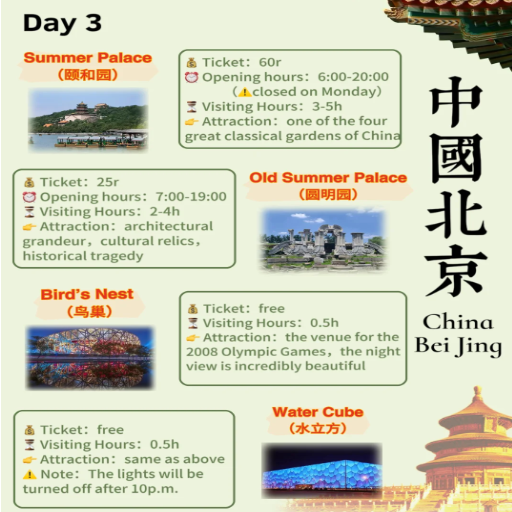
What Are the Highlights of Day 3 in Beijing
Day 3 Beijing is a combo of cultural and modern activities, as I put it. Begin by visiting the peaceful Temple of Heaven, a UNESCO World Heritage site that exhibits China’s spiritual and architectural wonders. Afterward, head to the lively 798 Art District, a contemporary art core comprising shops, cafes, and even more galleries. Finish the day with an evening walk on Wangfujing Street, famous for its mix of local foods, street food, and delicious shops. These places ensure an exciting and unforgettable third day in the city.
Exploring the Tranquil Summer Palace
Covering a total area of 290 hectares, the Summer Palace not only holds the most extended Man-made Renal right in Beijing but also serves as the largest and most splendid Royal Garden in China. Apart from its renowned reputation, the palatial garden impresses explorers with a combination of gorgeous sceneries and rich history behind it. This vast ensemble of lakes, gardens, and palaces in the Haidian District showcases traditional Chinese garden design. Other important Summer Palace landmarks include Kunming Lake, sprawling to almost seventy percent of the area, along with the two-hundred-foot-tall Longevity Hill. Walking through the Long Corridor tells the history and mythology of China City. It is sufficient to say that Long Corridor acts like a narrow, Swayed Park painted with a marvelous span of 700 meters.
To cover the outdoor sights, it is estimated that hours of exploration time would be optimal for a complete experience. This can be done between 5:30 and 7 and 8-6 November in April, moving forward to pre-seasons and off-season. Because of how it is managed and maintained, The Summer Palace is recommended to anyone traveling to China for its beauty and tranquility.
Discovering the Cultural Riches of the Lama Temple
The Yonghe Temple, or the Lama Temple, is another notable Buddhist Temple in Beijing that is a haven for culture and spirituality enthusiasts. Built-in 1694 during the Qing Dynasty, the temple was a royal palace before being changed to a lamasery in 1744. Today, the temple is a majestic converging point of Tibetan Buddhism and now serves as a place of worship and a tourist attraction due to its grandeur and peaceful ambiance.
The Temple complex is made up of five main halls, all of which are decorated with detailed carvings, murals, and statues. Among them is the Hall of Harmony and Peace (Yonghegong), where three bronze Buddha statues of the past, present, and future are kept, alongside the fantastic Maitreya Buddha statue, towering at 26 meters and created out of a single piece of sandalwood. This statue is recognized in the Guinness World Records. Apart from these, the finely painted ceiling and prayer wheels on the Hall of the Wheel of the Law always enthralled visitors.
Consider allocating 1-2 hours to explore the temple satisfactorily. Remember the opening hours: 9 AM to 4 PM. The average cost of admission is about 25 RMB, although it can vary. Visitors should also remember not to be overly loud or take suggestive pictures, as this is a religious site. Proper attire is required.
This Temple can be found in the Dongcheng District, which is user-friendly by public transport. Tourists may use the Beijing Subway Line 2 or 5 and disembark at Yonghegong Lama Temple Station. The temple is not far from the station, and it’s a quick stroll to the complex. Besides being rich in cultural history, Xiao Zang Si also embodies the spiritual essence of Buddhism, earning it the title of ‘Buddhist Holy Land.’
Strolling Through the Traditional Hutongs
Traveling through the traditional hutongs of Beijing is like going back in time to witness the authentic lifestyle and history of the city. These narrow passages are filled with ancient courtyard houses and provide a glimpse into the day-to-day lives of the locals. While strolling in these iconic places, you can find vibrant boutiques, lovely tea shops, and tasty street food on Mengfuchang and the relatively quieter Wudaoying Hutong. Most of the hutongs are best covered on foot or by using a bicycle. The complex web of paths makes it easy for people to navigate the area. Visiting in the morning or late afternoon is best to avoid the rush. These public spaces are usually free, but some private courtyards charge a small entry fee. This immersive experience mixes cultural exploration with modern-day liveliness, which makes the hutongs a crucial part of any Beijing visit.
Where to Stay in Beijing During Your Visit?
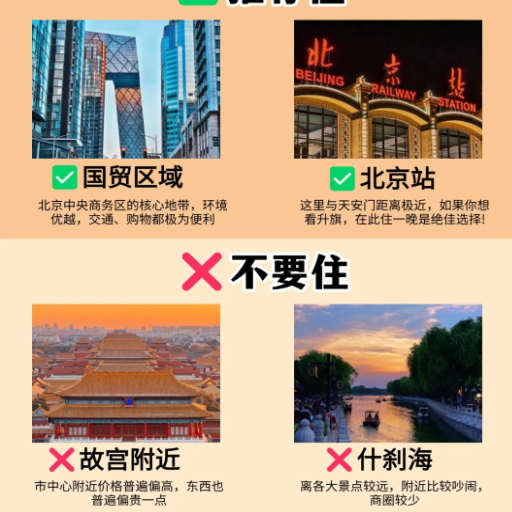
Where to Stay in Beijing During Your Visit
From luxurious hotels to budget-friendly hostels, Beijing has no shortage of places to stay. International hotel chains are located in Chaoyang and Wangfujing, so you can have a high-end experience with top-quality amenities. If you’re traveling for leisure, boutique courtyard hotels in Dongcheng District are ideal. These hotels are close to popular tourist spots like the Forbidden City and the Hutongs. For economical visitors, hostels and guesthouses in Xicheng provide comfortable accommodation at a low price. These guesthouses also offer easy access to public transportation. Choosing accommodation near a subway station for convenient traveling throughout the city is best regardless of where you stay.
Top Accommodation Options in Beijing City
- Rosewood Beijing
- Location: Chaoyang District, near Beijing CBD
- Features: Luxurious rooms, fine dining restaurants, spa, indoor pool
- Ideal For: High-end travelers seeking luxury and exclusivity
- The Orchid Hotel
- Location: Dongcheng District, close to the Drum and Bell Towers
- Features: Boutique courtyard hotel, traditional architecture, rooftop terrace
- Ideal For: Travelers desiring an authentic cultural experience near Hutongs
- Park Plaza Beijing Wangfujing
- Location: Wangfujing area, near the Forbidden City
- Features: Modern amenities, business facilities, on-site dining
- Ideal For: Tourists and business travelers wanting central access to attractions
- Peking International Youth Hostel
- Location: Dongcheng District, within walking distance of Yonghegong Lama Temple
- Features: Affordable dormitories and private rooms, cozy café, tour booking services
- Ideal For: Budget-conscious travelers and backpackers
- Shichahai Shadow Art Performance Hotel
- Location: Xicheng District, near Shichahai Lake
- Features: Culturally immersive experience with traditional shadow art performances
- Ideal For: Art and culture enthusiasts wanting a unique stay
The beauty of Beijing is that it offers several lodging options, from economical youth hostels to high-end hotels. Regardless of your travel priorities, there is always a location and facilities that perfectly fit your family’s needs for an exceptional trip!
Choosing the Best Neighborhood for Your Stay
Each part of Beijing is unique, and the experiences that different city neighborhoods offer are unparalleled. Choosing the best area in the town, whether for accommodation or general sightseeing, depends on personal preferences such as food, culture, and more. To help you make a better planning decision, here are some neighborhoods and what they have to offer:
- Dongcheng District
- Highlights: The heart of the city and a shopping hub, Dongcheng is highly recommended for first-time tourists who seek entertainment and traditional sites like The Forbidden City, Tiananmen Square, and Yonghegong Lama Temple. Wangfujing is in Dongcheng, one of Beijing’s most popular shopping streets. This area is also known for its traditional courtyard homes.
- Best For: People interested in History and culture want convenient access to places of interest.
- Transportation: Bus and metro services are excellent, enabling easy travel to other parts of the city.
- Chaoyang District
- Highlights: These districts contain elite shopping centers and restaurants offering food from around the globe alongside rich nighttime entertainment. This district also contains Chaoyang Park and the 798 Art District, attracting many for modern and contemporary art. Because of its attractions, this area is in high demand by foreign employees, business visitors, and tourists.
- Best For: Business travelers and foreigners looking for luxury entertainment and rich nightlife.
- Transportation: Major metro stations and Beijing Capital International Airport proximity offer great connections.
- Xicheng District
- Highlights: This district is famous for the scenic Shichahai region, with its stunning lakes and ancient hutongs, alongside unique attractions like the Beijing Zoo and the National Centre for Performing Arts. It represents a combination of modern civilization and natural beauty.
- Best For: Family, art lovers, or those looking for calm, quiet accommodation in a central location.
- Transportation: An efficient metro system within walking distance of numerous sites of interest.
- Haidian District
- Highlights: This district is quieter than the central districts and is located near the top universities in Beijing, such as Peking University and Tsinghua University. It also has the Summer Palace and Yuanmingyuan Park.
- Best For: Academics, nature lovers, or people who plan to stay long.
- Transportation: It can be reached by metro; however, it is set further away from the central city attractions.
- Sanlitun Area (Chaoyang Subzone)
- Highlights: Taikoo Li is an active hotspot for nightlife, including clubs, bars, international cuisines, and luxury shopping. It is ideal for those who like a mixed crowd of locals and foreigners in a modern atmosphere.
- Best For: Young travelers, food enthusiasts, and those searching for nightlife.
- Transportation: Easy access to public transport and very walkable.
Every area in Beijing has unique benefits, making selecting one that matches your travel style easy. Remember to consider nearby points of interest, available transportation, and services to guarantee a fantastic experience!
Luxury vs Budget: Finding the Right Fit for Your Itinerary
While preparing for my visit to Beijing, I had to find the proper balance between luxury and budget, which catered to my preferences. For a luxurious stay, catching a room at five-star hotels such as Rosewood Beijing and Aman Summer Palace proved a good option as I could enjoy exquisite dining and spa services and their locations near essential landmarks. Their prices usually varied between $300 and $800 per night. On the contrary, for a budget option, I could find hostels and clean but cheap hotels like the Beijing Downtown Backpackers Accommodation, which provided rooms at $20 to $50 a night with amenities such as free Wi-Fi and common cooking areas.
What best suits you depends on your travel goals. If comfort, premium facilities, and overall pampering are essential, then it would be reasonable to spend on luxury. However, doing so would allow saving money for activities and excursions. If both, you can meet your needs and finances by prioritizing location, provided services, and daily routine.
References
Frequently Asked Questions (FAQ)
Q: What is the best time to visit Beijing for a 3-day itinerary?
A: The best time to visit Beijing for a 3-day itinerary is during the spring (April to June) or autumn (September to October), when the weather is pleasant and the attractions are less crowded.
Q: How can I get to Beijing from other major cities like Shanghai?
A: To get to Beijing from cities like Shanghai, you can take a high-speed train, which is efficient and takes around 4 to 6 hours, or you can fly, with multiple daily flights available. Both options offer a convenient way to start your 3-day Beijing adventure.
Q: What are the must-see attractions in Beijing for a 3-day tour itinerary?
A: A 3-day Beijing tour itinerary should include must-see attractions like the Great Wall, Tiananmen Square, the Forbidden City, the Summer Palace with the Tower of Buddhist Incense, and a stroll through the Beijing Hutongs to taste traditional Beijing.
Q: How do I get around Beijing during my 3-day itinerary?
A: You can get around Beijing using the efficient subway system, buses, or taxis. Hiring a private tour guide can also be beneficial for a personalized experience, ensuring you make the most of your time in Beijing.
Q: Is English widely spoken in Beijing, and will I need a tour guide?
A: While some people in tourist areas and hotels speak English, it’s helpful to have a tour guide who speaks English to navigate the city and understand the historical context of the attractions during your China tour.
Q: What local dishes should I try while spending 3 days in Beijing?
A: While spending 3 days in Beijing, you should try Peking Duck, one of the most famous local dishes, and traditional Beijing snacks from the street markets for an authentic culinary experience.
Q: Can I visit the Great Wall during my 3-day Beijing itinerary?
A: Visiting the Great Wall is highly recommended during your 3-day Beijing itinerary. The Mutianyu section is a popular choice as it is less crowded and offers stunning views of the surrounding landscape.
Q: What historical sites related to the Ming and Qing Dynasties should I visit in Beijing?
A: In Beijing, you should visit the Forbidden City, which served as the imperial palace for 24 emperors during the Ming and Qing Dynasties, and the Temple of Heaven, where emperors prayed for good harvests.
Q: How can I experience both modern and ancient China during my time in Beijing?
A: To experience both modern and ancient China during your time in Beijing, explore the futuristic architecture of the Central Business District alongside historical sites like the Beijing Hutongs and the Summer Palace.